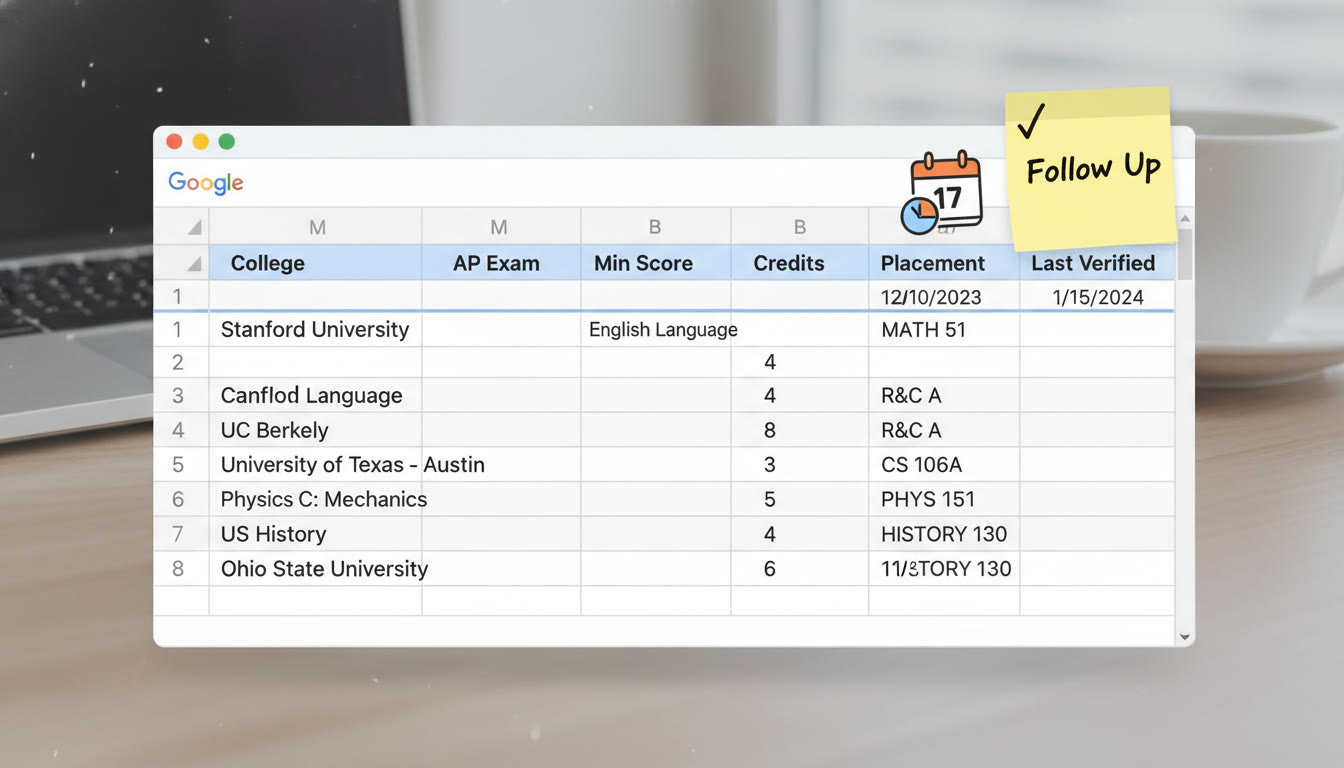Why You Need a College-by-College AP Credit & Placement Spreadsheet
If you’re taking AP exams—or planning to—you’re not just chasing high scores for the thrill of it. You’re building tangible advantages: saved tuition, fewer required classes, the flexibility to minor or double major, and room for internships or study abroad. But colleges treat AP scores differently. Some grant full course credit for a 4 or 5, some give placement only, and others are more conservative. A single, well-organized spreadsheet that lists each college’s credit and placement policy for your AP exams turns confusion into clarity.
This post walks you through why the spreadsheet matters, how to build it step by step, what fields to include, how to verify policies, and how to use it to make real decisions. I’ll share templates, sample rows, prioritization strategies, and real-world examples so you can walk away with a fully functional tool tailored to your goals. And if you want extra help turning this into action, Sparkl’s personalized tutoring—1-on-1 guidance, tailored study plans, expert tutors, and AI-driven insights—can slot in where you need an accountability partner or a deeper review of complex policies.

Step 1 — Define Your Goal: Credit, Placement, or Both?
Before you open a spreadsheet, be clear about what matters most to you. Are you aiming to:
- Enter college with actual academic credit that counts toward graduation?
- Skip entry-level courses and place directly into higher-level classes?
- Use AP credits to graduate early or free up semesters for internships?
- Or a mix of these goals?
Knowing this helps you prioritize which colleges and which AP exams matter most. For instance, if your goal is to graduate early, credits (not placement) matter more. If you’re aiming to start in advanced major courses, placement is critical.
Step 2 — Gather a Target List of Colleges
Start with a list of the colleges you’re most likely to apply to or attend. Group them into tiers: Reach, Match, and Safety. Include any community colleges or state universities you might transfer to. Your spreadsheet will be most useful if it compares apples to apples—so think breadth (geographic and selectivity) and depth (schools with strong programs in your intended major).
Helpful column idea: Campus vs System
Some universities (especially state systems) have system-wide AP policies, while others let each campus decide. Note whether a policy is campus-level or system-level; that will help when you verify details.
Step 3 — Decide the Spreadsheet Structure (Columns to Include)
A robust spreadsheet balances detail with readability. Here are the recommended columns and why each matters:
- College Name — Full official name of the school.
- Campus / System — If applicable, the particular campus (e.g., University of X – Main Campus).
- AP Exam — The specific AP subject (e.g., Calculus AB, Biology, English Language).
- Minimum Score for Credit — The score (e.g., 3, 4, 5) required to earn college credit.
- Credits Granted — Number of semester or quarter hours given for that score.
- Minimum Score for Placement — The score that grants advanced placement (may differ from credit).
- Placement Details — Which college course(s) you can skip or which course level you place into.
- Notes — Any nuances, such as “credit but not toward major” or “credit for elective only.”
- Effective Date / Last Verified — When you checked the policy; policies can change, so include an exact date.
- Score Send Deadline — If a college has an internal deadline for receiving AP scores, note it here.
- Policy URL (internal use) — Where you found the policy; keep it for quick re-verification (do not publish this if you share your spreadsheet).
Step 4 — Collect Accurate Policies (Where and How to Look)
Authoritative information typically comes from the college’s registrar, admissions, or AP credit policy pages. When you research each school:
- Search the college’s official site for “AP credit policy,” “AP credit and placement,” or “AP equivalency.”
- Note whether the policy differentiates by major—some colleges award general elective credit but not major credit unless departments approve it.
- Check whether they require an official score report sent from the AP program (most do) and note deadlines. Colleges often require scores to arrive before orientation or a registrar deadline.
- If the policy is ambiguous, contact the registrar or departmental advisor and save an email or note summarizing their response.
Because policies change, add the date you verified the policy. If you check again later (recommended annually or before you send scores), update that date.
Step 5 — Populate Your Spreadsheet: A Sample Table
Here is an example of how rows might look for three colleges across three AP exams. Use semester hours for consistency or indicate if a school uses quarter hours.
| College | AP Exam | Min Score (Credit) | Credits Granted | Min Score (Placement) | Placement Result | Notes | Last Verified |
|---|---|---|---|---|---|---|---|
| State University A | Calculus AB | 4 | 4 semester hrs | 4 | Place into Calculus II | Credit counts toward major math requirement | 2025-06-18 |
| Private College B | Biology | 3 | 4 semester hrs | 4 | Can skip Intro Bio lab course | Major department approval required for lab substitution | 2025-07-02 |
| Community College C | English Language | 3 | 3 semester hrs | 3 | Place into English 102 | Applies to general education only | 2025-05-25 |
This table is a compact snapshot. In practice, your sheet will likely have dozens of rows as you repeat these cells for each AP subject and each college.
Step 6 — Prioritize and Score Each College
With policies logged, you need a quick way to compare and prioritize colleges. Add three columns: Credit Value, Placement Value, and Overall Benefit Score. Assign points based on how many credits you’d earn, whether the credit counts for your major, and if placement saves you a prerequisite year.
- Credit Value: 0–5 scale (0 = no credit, 5 = significant credit that reduces time to degree).
- Placement Value: 0–5 scale (0 = no placement, 5 = direct entry into upper-division major courses).
- Overall Benefit Score: sum or weighted sum based on what you value (e.g., if graduating early is most important, give Credits higher weight).
Sort your spreadsheet by Overall Benefit Score to see which colleges reward your AP work the most. That’s an evidence-based way to weigh decisions like where to apply early or where to accept offers.
Step 7 — Use the Spreadsheet for Real Decisions
Here’s how to convert data into action:
- If a college awards significant credits for your key AP exams, consider applying there or meeting any departmental requirements to secure those credits.
- For colleges that grant placement but not credit, plan how that placement will affect your major timeline (it may allow you to take advanced courses earlier, which can be invaluable).
- Check score-send costs and deadlines. Every year you can send one free score report; use it strategically for a top-priority school that year.
- If a policy has conditional language (“may count toward major”), reach out to the department for a written confirmation or add a note to follow up after admission.
Step 8 — Maintain the Spreadsheet
Policies change. Build a maintenance plan:
- Set calendar reminders to re-verify each school’s policy every 6–12 months, and always before you send official scores.
- Update the “Last Verified” column whenever you check a policy.
- Keep emails or screenshots of department confirmations in a folder tied to your spreadsheet for quick reference.
Common Complications and How to Handle Them
Here are recurring snags students run into and practical ways to manage them.
1. Quarter Hours vs. Semester Hours
Some colleges report credit in quarter hours. Convert quarter hours to semester hours (quarter hours × 2/3 = semester hours) and include the converted value so you can compare apples to apples.
2. Credit That Doesn’t Count Toward the Major
A college might give elective credit but not count an AP exam toward your major requirements. Note this clearly. If major credits are important, prioritize colleges that explicitly grant major-specific credit.
3. Departmental Overrides or Portfolio Reviews
Sometimes a department requires a portfolio, exam, or faculty review to grant major credit. Treat these as extra tasks: add a “Follow-up Required” flag and include contact names if you can get them.
4. Policy Ambiguity
If a web page is vague, call or email the registrar or department and ask specific questions. Copy brief responses into your spreadsheet and mark them with the date and the person you contacted.
How to Tailor Your Approach by Major
Majors matter. The same AP exam can have very different value depending on your intended field of study.
- STEM majors: AP Calculus, AP Chemistry, and AP Physics often have the highest impact—both in credit and placement—because they directly map to major prerequisites.
- Humanities majors: AP English, History, and Languages can often satisfy general education or major requirements, but verify whether the department accepts AP for upper-level course substitutions.
- Pre-professional paths: Engineering, nursing, and education sometimes have accreditation-driven course sequences, so placement may be more helpful than elective credit.
In your spreadsheet, create a filtered view or a separate sheet that highlights AP exams most relevant to your chosen major—this helps you focus your study and score-send strategy.
Practical Example: How One Student Used the Spreadsheet
Meet Maya (a hypothetical but typical student). She’s targeting a STEM major and has taken AP Calculus BC, AP Biology, and AP Chemistry. She built a spreadsheet of 12 schools. After populating policies and scoring each row, she discovered three things:
- Two state universities would award eight credits for Calculus BC and place her into Multivariable Calculus—huge time savings.
- One private college gave placement for Calculus but did not award credit—still valuable because it let her take upper-level courses sooner.
- Several schools required department approval for lab course equivalencies, so she added follow-up steps to her cycle.
Maya used her spreadsheet to prioritize applications and to decide where to send her free score this year. Post-admission, she used the same sheet to plan course registration and confirm which credits would appear on her transcript.
Spreadsheet Tools and Templates
You can build this in Google Sheets, Excel, or any tool that supports filtering, sorting, and sharing. Google Sheets is particularly useful because you can access it from anywhere and share it with a counselor or parent. Key tips:
- Use data validation (drop-downs) for the AP Exam column to keep entries consistent.
- Color-code cells (e.g., green = high benefit; yellow = medium; red = low) so you can visually scan priorities.
- Use freeze rows for header visibility and filters on columns like “AP Exam” and “College” for quick comparison.
Image Idea In-Context

How to Send Scores Strategically
Remember, sending official AP scores is the only way a college can grant credit/placement. Each year you take AP Exams, College Board typically lets you send one free score report—use it wisely. Here’s a strategy:
- During your junior year, send your free score report to a top-choice college that would benefit most from early score submission.
- If you take multiple APs across different years, rotate which college gets the free report so more schools can see your progress.
- Always check the college’s internal deadline for receiving AP scores—some have early deadlines for incoming freshmen to claim credit before orientation or registration.
When to Get Extra Help
Building and maintaining this spreadsheet is a research and organization task—and sometimes it’s easier and faster with guidance. If you find policy language confusing, or if you want help prioritizing which colleges to focus on, consider tutoring or advising support. Sparkl’s personalized tutoring can help you interpret policies, build the spreadsheet with you in real time, or create a tailored score-send and study plan based on the credits and placement each college offers. That kind of 1-on-1 guidance can be especially helpful if you’re applying to many schools or chasing a competitive major.
Final Checklist Before You Send Scores
- Have you verified the college policy within the past 12 months and recorded the date?
- Do you know which scores grant credit versus placement?
- Are credits listed in semester hours or quarter hours? Did you convert them?
- Have you noted any major-specific restrictions?
- Are there internal deadlines at the college for receiving AP reports? If so, have you set calendar reminders?
- If you relied on an email confirmation from a department, is that email saved and referenced in your spreadsheet?
Tips for Making the Spreadsheet a Living Resource
The most useful spreadsheets are the ones you actually update. Make it part of your application workflow:
- Schedule a 30-minute refresh session every semester.
- After each AP exam season, update the score-sending column and adjust priorities.
- If you get admitted, add a column for “Applied Credit Received” and track what actually posted on your college transcript—this becomes valuable data for future students in your school or for your transfer decisions.
Parting Advice: Think Strategically, Not Just Maximally
It’s tempting to chase every possible credit, but not all credits are equal. Some credits might only be electives that won’t shorten your time to degree. Others may open the crucial door to upper-level courses that shape your major experience. Use your spreadsheet to identify which credits are transformational for your academic plan, and focus your attention there.
And remember: a spreadsheet is only a tool. The human parts—asking questions, following up with departments, and planning your academic trajectory—are what turn data into opportunity. If you want hands-on help building a tailored spreadsheet, interpreting departmental language, or creating a score-send strategy, Sparkl’s personalized tutoring is an excellent place to get that kind of 1-on-1 support and AI-assisted planning.
Quick Resources to Copy into Your Sheet
To speed you up, here are sample column headers you can paste straight into a new sheet:
- College Name
- Campus/System
- AP Exam
- Min Score (Credit)
- Credits Granted (sem hrs)
- Min Score (Placement)
- Placement Outcome
- Major Credit? (Yes/No)
- Policy Nuances
- Last Verified (YYYY-MM-DD)
- Score Send Deadline
- Overall Benefit Score
- Follow-up Contact
Conclusion
Building a college-by-college AP credit and placement spreadsheet is one of the highest-leverage planning moves you can make as an AP student. It turns scattered policy pages into a single decision engine that helps you prioritize where to apply, where to send scores, and how to plan your first year of college. It also gives you the clarity to make educated trade-offs—should you aim for a 5 in Calculus BC to save a semester, or focus efforts elsewhere?
Start simple, keep it updated, and use the spreadsheet to focus on what will truly help you academically and financially. If you ever want a partner in building the sheet or interpreting complicated departmental rules, consider bringing in 1-on-1 help from an expert—Sparkl’s tutors can help you convert the research into a customized plan that matches your goals.
Good luck: organize well, verify thoroughly, and let your AP work do the heavy lifting as you move toward college.























No Comments
Leave a comment Cancel